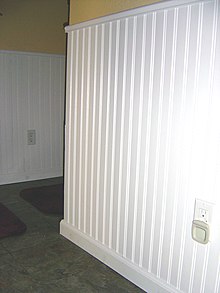Panelling


Panelling is a blanket term for wall coverings constructed from rigid or semirigid components. These are traditionally interlocking wood, but could be plastic or other materials.
Panelling was developed in antiquity to make rooms in stone buildings more comfortable. The panels served to insulate the room from the cold stone. In more modern buildings, such panelling is often installed for decorative purposes. Panelling, such as wainscoting and boiserie in particular, may be extremely ornate and is particularly associated with 17th and 18th century interior design, Victorian architecture in Britain, and its international contemporaries.
Wainscoting
Wainscot or wainscoting (pronounced /ˈweɪnskɔtiŋ/ in American English, /ˈweɪnskɒtɪŋ/ in British English) is a panelling style applied to the lower 1.2 to 1.5 m of an interior wall, below the dado rail or chair rail and above the skirting board or baseboard. It is traditionally constructed from tongue-and-groove boards, though beadboard or decorative panels (such as a wooden door might have) are also common. Wainscoting may also refer to other materials used in a similar fashion.
Its original purpose was to cover the lower part of walls which, in houses constructed with poor or nonexistent damp-proof courses, are often affected by rising dampness. Though some countries may impose building regulations for adequate damp-proofing, its purpose is now generally decorative.
Boiserie
Boiserie (often used in the plural boiseries) is the term to used to define ornate and intricately carved wood panelling. Early examples of boiseries were unpainted, but later the raised mouldings were often painted or gilded. Boiseries were popular in 17th and 18th century French interior design and the Palace of Versailles has many fine examples. The panels were not confined just to the walls of a room but were also used to decorate doors, frames, cupboards and shelves. Often pictures would be set into the boiseries, the carving framing the picture rather like a conventional frame.
